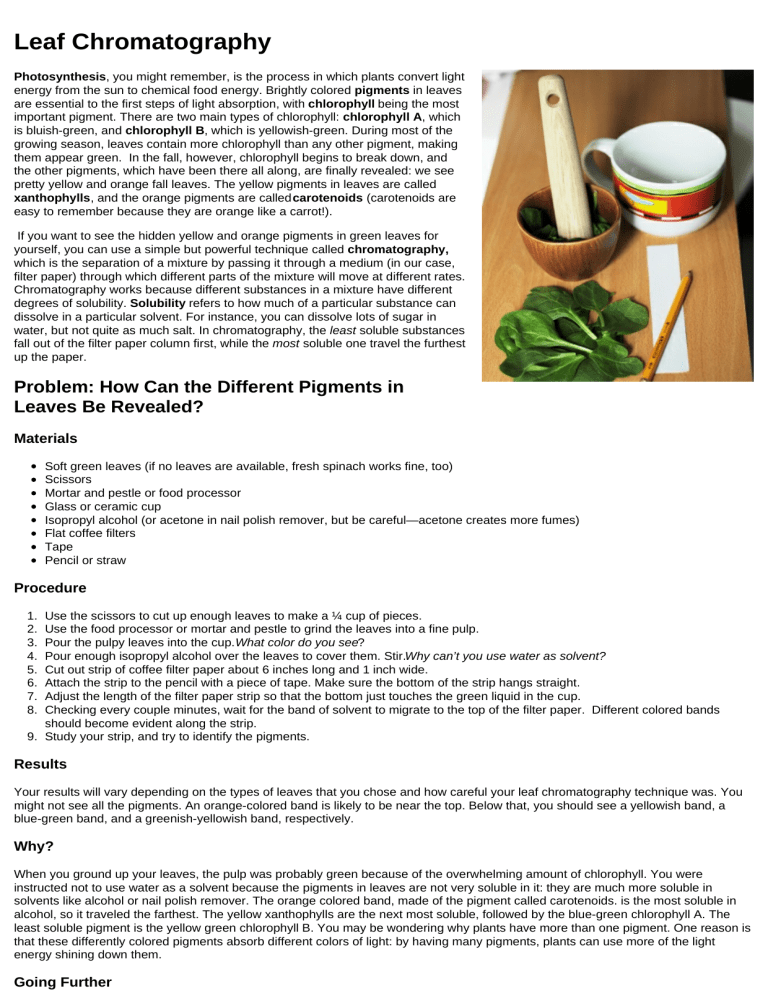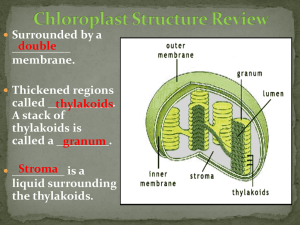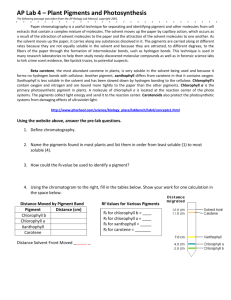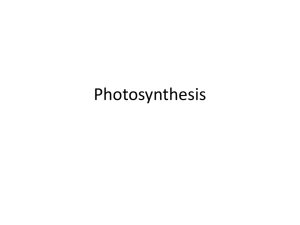
Leaf Chromatography Photosynthesis, you might remember, is the process in which plants convert light energy from the sun to chemical food energy. Brightly colored pigments in leaves are essential to the first steps of light absorption, with chlorophyll being the most important pigment. There are two main types of chlorophyll: chlorophyll A, which is bluish-green, and chlorophyll B, which is yellowish-green. During most of the growing season, leaves contain more chlorophyll than any other pigment, making them appear green. In the fall, however, chlorophyll begins to break down, and the other pigments, which have been there all along, are finally revealed: we see pretty yellow and orange fall leaves. The yellow pigments in leaves are called xanthophylls, and the orange pigments are called carotenoids (carotenoids are easy to remember because they are orange like a carrot!). If you want to see the hidden yellow and orange pigments in green leaves for yourself, you can use a simple but powerful technique called chromatography, which is the separation of a mixture by passing it through a medium (in our case, filter paper) through which different parts of the mixture will move at different rates. Chromatography works because different substances in a mixture have different degrees of solubility. Solubility refers to how much of a particular substance can dissolve in a particular solvent. For instance, you can dissolve lots of sugar in water, but not quite as much salt. In chromatography, the least soluble substances fall out of the filter paper column first, while the most soluble one travel the furthest up the paper. Problem: How Can the Different Pigments in Leaves Be Revealed? Materials Soft green leaves (if no leaves are available, fresh spinach works fine, too) Scissors Mortar and pestle or food processor Glass or ceramic cup Isopropyl alcohol (or acetone in nail polish remover, but be careful—acetone creates more fumes) Flat coffee filters Tape Pencil or straw Procedure 1. 2. 3. 4. 5. 6. 7. 8. Use the scissors to cut up enough leaves to make a ¼ cup of pieces. Use the food processor or mortar and pestle to grind the leaves into a fine pulp. Pour the pulpy leaves into the cup. What color do you see? Pour enough isopropyl alcohol over the leaves to cover them. Stir.Why can’t you use water as solvent? Cut out strip of coffee filter paper about 6 inches long and 1 inch wide. Attach the strip to the pencil with a piece of tape. Make sure the bottom of the strip hangs straight. Adjust the length of the filter paper strip so that the bottom just touches the green liquid in the cup. Checking every couple minutes, wait for the band of solvent to migrate to the top of the filter paper. Different colored bands should become evident along the strip. 9. Study your strip, and try to identify the pigments. Results Your results will vary depending on the types of leaves that you chose and how careful your leaf chromatography technique was. You might not see all the pigments. An orange-colored band is likely to be near the top. Below that, you should see a yellowish band, a blue-green band, and a greenish-yellowish band, respectively. Why? When you ground up your leaves, the pulp was probably green because of the overwhelming amount of chlorophyll. You were instructed not to use water as a solvent because the pigments in leaves are not very soluble in it: they are much more soluble in solvents like alcohol or nail polish remover. The orange colored band, made of the pigment called carotenoids. is the most soluble in alcohol, so it traveled the farthest. The yellow xanthophylls are the next most soluble, followed by the blue-green chlorophyll A. The least soluble pigment is the yellow green chlorophyll B. You may be wondering why plants have more than one pigment. One reason is that these differently colored pigments absorb different colors of light: by having many pigments, plants can use more of the light energy shining down them. Going Further Investigate what colors of light plants grow best in. Buy a green, blue and red light bulb. See what color of light seem to be the best for growth. Copyright © 2018 Education.com LLC All Rights Reserved





